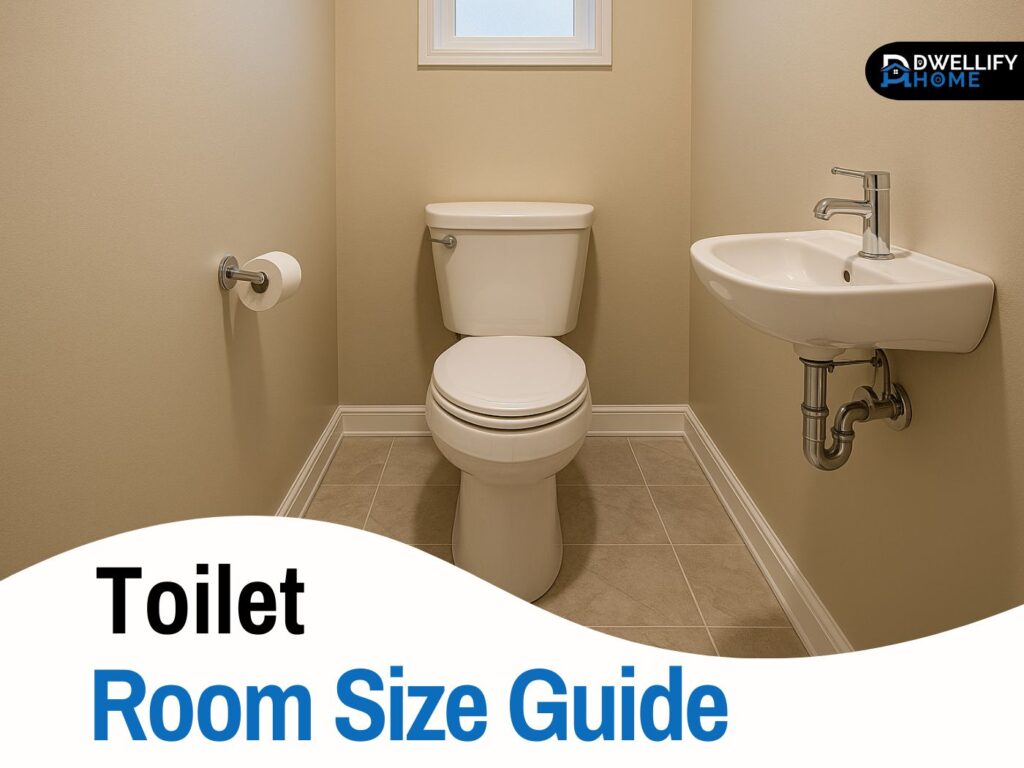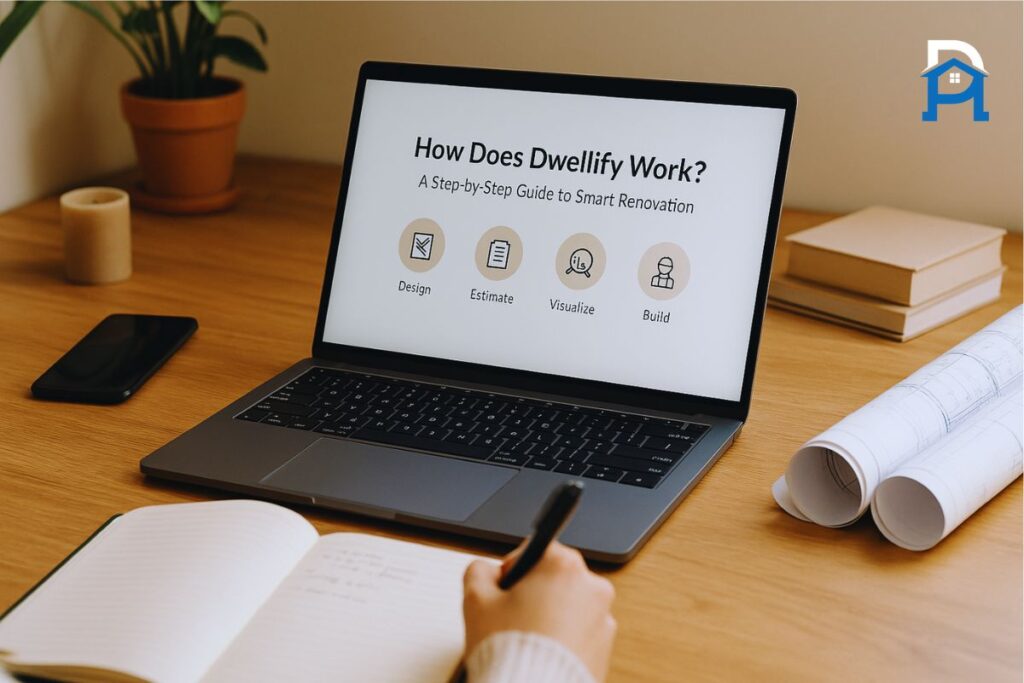When you’re planning or remodeling a bathroom, one detail that makes a bigger difference than most people realize is the toilet room size. At first glance, it might seem like just a small detail, but the truth is, a poorly planned toilet room can feel cramped, uncomfortable, and even fail to meet code requirements. On the flip side, getting the size right adds comfort, privacy, and convenience to your everyday life.
Here’s the thing: there’s no one-size-fits-all answer. The minimum required dimensions for a toilet room are set by building codes, but those are often just the bare minimum. If you’ve ever tried to use a toilet in a space that felt way too tight, you know why it’s worth going beyond the smallest numbers. In this guide, we’ll break down the minimums, the recommended sizes, and smart design tips so you can create a bathroom that’s not only functional but also comfortable.
Short Definition:
Toilet room size refers to the dimensions of a bathroom space dedicated to a toilet. Standard sizes range from a 30×60-inch minimum to larger, more comfortable layouts around 36×66 inches or more, depending on function and design.
Mission Statement
Our mission is to provide homeowners, designers, and renovators with clear, practical, and expert-backed guidance on toilet room size. We aim to simplify complex codes and design standards into easy-to-understand advice, helping you create bathrooms that are safe, comfortable, functional, and future-ready for every lifestyle.
Standard and Minimum Toilet Room Sizes
If you’re starting from scratch or reworking an existing layout, the first thing you need to know is the difference between minimum code requirements and what’s actually comfortable for daily use. Building codes make sure the toilet room is safe and functional, but let’s be honest, minimum doesn’t always mean pleasant.
Code-Based Minimums (USA and International)
Most building codes set the smallest toilet room at 30 inches wide by 60 inches deep. That’s 2.5 feet by 5 feet, or about 0.76 meters by 1.52 meters. You also need at least 21 inches (about 53 centimeters) of clear space in front of the toilet so your knees don’t bump into the wall or door. On the sides, the centerline of the toilet must be at least 15 inches away from any wall or obstruction.
Technically, that’s legal and safe. But in reality, that size often feels a bit tight. Imagine standing in a narrow hallway—that’s kind of the same feeling. It works, but it doesn’t feel comfortable.
Comfortable Toilet Room Dimensions
Most designers recommend going a little bigger than the bare minimum. A comfortable toilet room size is usually about 36 inches wide and 66 inches deep. That’s 3 feet by 5.5 feet, or 0.91 meters by 1.67 meters. You’ll also want 24 to 30 inches of clear space in front of the toilet. That extra foot of room makes a huge difference in how the space feels and functions.
If you’re adding a sink to the toilet room, plan for at least another 12 inches of width. Otherwise, you’ll end up with a sink that feels crammed right next to the toilet, which isn’t ideal for daily use.
Toilet Room Size in Feet, Meters, Inches and Cm
People often search for toilet room size in different units, so here’s a quick reference to make it easier:
- Minimum toilet room: 30” × 60” (2.5 ft × 5 ft or 0.76 m × 1.52 m)
- Comfortable size: 36” × 66” (3 ft × 5.5 ft or 0.91 m × 1.67 m)
- Front clearance: 21” minimum (53 cm), 24–30” recommended (61–76 cm)
- Side clearance: 15” minimum (38 cm), 18” recommended (46 cm)
Guess what? Just a few extra inches in width or depth can transform the space from “barely usable” to “surprisingly comfortable.” If you’ve ever squeezed into a powder room that felt too tight, you know exactly what I mean.
Average Toilet Room Size in Homes
On average, a toilet room in a master bathroom is around 3 feet wide by 6 feet deep. Smaller half-bath or powder room toilet spaces may only be 3 feet by 5 feet. In metric terms, that’s anywhere from about 0.9 × 1.5 meters up to 0.9 × 1.8 meters.
For larger homes, especially those with luxury master bathrooms, toilet rooms can be much bigger, often 42 inches wide or more, giving you plenty of space for comfort and even extra features like shelves or a bidet.
Toilet Room in Different Settings
Not all toilet rooms are the same. The size you need often depends on where the toilet is located in your home and what function that space serves.
Size of Toilet Room in Master Bathroom
In master bathrooms, many homeowners prefer an enclosed toilet room for added privacy. Since the master suite is usually more spacious, the toilet room here can be larger than average. Instead of sticking with the bare 30 inches, you’ll often see 42 inches (about 3.5 feet) or even 48 inches (4 feet) in width. The depth may also stretch beyond 6 feet.
Why does that matter? Well, larger toilet rooms feel less claustrophobic and allow you to add extras like a small window, built-in shelves, or even a second fixture like a bidet. If you’re investing in a master bathroom remodel, it’s worth going bigger so the space feels just as luxurious as the rest of the suite.
Small Toilet Room Dimensions
Not every home has the space for a master-sized toilet room. In smaller houses, apartments, or half-bathrooms, you may only have space for the minimum toilet room size. Small toilet room dimensions usually fall around 30 inches wide by 60 inches deep. Some compact designs go down to 0.95 m × 1.4 m (roughly 3.1 ft × 4.6 ft).
Here’s the best part: even if you’re stuck with a small footprint, there are ways to make it feel bigger. A pocket door can free up several inches of clearance. Choosing a wall-hung toilet saves floor space and creates a more open look. Using light colors, mirrors, and clever storage tricks also help.
Enclosed Toilet Room Size
An enclosed toilet room simply means the toilet is in a separate compartment with a door. These are common in master bathrooms and sometimes in shared family bathrooms. The average enclosed toilet room size ranges from 3 ft × 5 ft up to 4 ft × 6 ft.
The big advantage of an enclosed toilet room is privacy. Someone can use the toilet while another person uses the shower or sink. The challenge is making sure the enclosed space doesn’t feel like a closet. Proper ventilation, lighting, and at least 36 inches of width make all the difference.
Accessibility and ADA Requirements
When it comes to planning a toilet room, it’s not just about comfort. Accessibility plays a huge role, especially if you want your home to be welcoming to everyone or if you’re planning to age in place.
Minimum ADA Toilet Room Size
The Americans with Disabilities Act (ADA) sets clear requirements for toilet room dimensions to make them wheelchair-friendly. The minimum ADA toilet room size usually requires at least a 60-inch (5-foot) turning radius, which allows a wheelchair to maneuver comfortably. On top of that, you need clear space beside the toilet—at least 16 to 18 inches from the wall to the centerline of the toilet—to make side transfers possible.
That means if you want your toilet room to be ADA-compliant, it needs to be much bigger than the bare minimum 30 × 60-inch space. Think closer to 5 × 5 feet or even larger. This ensures not only accessibility but also safety for anyone with mobility challenges.
Universal Design and Future-Proofing
Here’s the thing—designing for accessibility isn’t just about meeting codes. It’s also about future-proofing your home. Even if you don’t need an ADA-compliant bathroom right now, making it a little bigger and more accessible can save you from expensive renovations later.
Some smart design choices include:
- Using a pocket door instead of a swing door to save space and allow easier access.
- Making the doorway at least 32 inches wide, ideally 36 inches.
- Planning for grab bar placement on the wall next to the toilet.
- Leaving extra clearance in front of the toilet for ease of movement.
Think of it as designing for your future self—or for guests who may have accessibility needs. It’s a small investment now that pays off in comfort and practicality down the line.
Key Design and Functional Considerations
Getting the size right is just one piece of the puzzle. The way you design and lay out the space can make a small toilet room feel either cramped or surprisingly comfortable.
Clearances Around the Toilet
We already mentioned that 21 inches is the minimum clearance in front of a toilet, but let me tell you, bumping your knees against a wall every time you sit down isn’t fun. Most designers recommend 24 to 30 inches in front for a more comfortable experience.
On the sides, 15 inches from the toilet’s centerline to the nearest wall or fixture is required by code, but 18 inches feels much better. If you’ve ever had your elbow brush against the wall while reaching for toilet paper, you’ll understand why those extra inches matter.
Adding a Sink Inside the Toilet Room
Sometimes people want to squeeze a sink inside the toilet room for convenience. That’s a great idea, but here’s the catch—you need more space. Adding even a small pedestal or wall-mounted sink usually requires at least 12 extra inches of width.
If your toilet room is only 30 inches wide and you add a sink, you’ll feel like you’re in an airplane bathroom. But if you go up to 42 inches or more, you’ll have a much more functional and comfortable setup.
Door Swing vs Pocket Door
Doors are an often-overlooked detail, but they can make or break a toilet room. A standard swing door can eat up valuable space inside, and sometimes it even collides with the toilet or sink. That’s why many designers recommend using a pocket door—it slides neatly into the wall and saves precious clearance.
If a pocket door isn’t possible, consider an outward-swinging door. Just make sure it doesn’t block hallways or create another problem outside the toilet room.
Ventilation, Lighting, and Privacy
Toilet rooms are often small and enclosed, which means poor ventilation can quickly become a problem. Always plan for an exhaust fan, and if possible, add a small window. Not only does this improve air quality, but it also makes the space feel less like a closet.
Lighting matters too. A bright overhead light or a wall sconce can make even a small toilet room feel more open. And don’t forget about acoustic privacy—nobody wants bathroom sounds traveling through thin walls. Solid doors and thoughtful layout can go a long way.
Designing for Small Toilet Rooms
Not every home has the luxury of a big bathroom. In apartments, older houses, or half baths, the toilet room often has to fit into a small footprint. The good news is, with a few smart design choices, even a small toilet room can feel comfortable.
Space-Maximizing Strategies
When you’re tight on space, every inch counts. Here are some tricks that really help:
- Wall-hung toilets: These are mounted to the wall with the tank hidden inside the wall cavity. This saves several inches of floor space and gives the room a cleaner, less cluttered look.
- Pocket doors: Instead of swinging into the room, a pocket door slides into the wall. This alone can free up a good 8 to 10 inches of usable space.
- Compact fixtures: Narrow sinks or corner sinks are lifesavers in tiny toilet rooms. They add functionality without making the room feel cramped.
Here’s the thing—you don’t need a giant space to have a functional toilet room. It’s about making smart choices with the little space you do have.
Visual Tricks for Small Spaces
Beyond physical dimensions, design tricks can make a small toilet room feel larger than it really is.
- Light colors: Whites, soft grays, and pastels reflect light and open up the space.
- Mirrors: A mirror opposite the door can create the illusion of depth.
- Floating shelves or recessed niches: Instead of bulky cabinets, opt for sleek storage solutions.
- Minimalist style: Keep décor simple—too many accessories will make the space feel cluttered.
Guess what? I once remodeled a powder room that was barely 3 × 5 feet. By adding a wall-hung toilet, a pocket door, and painting it a soft off-white, the room went from “tight closet” to “cozy little nook.” It’s all about perception.
Acceptable Minimums vs True Comfort
Yes, you can legally build a toilet room that’s 30 × 60 inches. But will it feel good to use? Honestly, not really. That’s like flying economy on a budget airline: it works, but it’s not comfortable.
Most homeowners who go through renovations end up choosing at least 36 × 66 inches. That extra space makes sitting down, standing up, and moving around feel much easier. If you’re deciding between meeting the minimum or adding an extra foot, go bigger if you can—it’s one of those small upgrades that makes daily life noticeably better.
Designing Larger or Premium Toilet Rooms
If you’ve got the square footage, designing a larger toilet room can add a real sense of luxury. Think of it as the difference between a compact car and a roomy SUV—they both get the job done, but one feels a lot more comfortable.
Enclosed Toilet Room in Master Suites
In many high-end master bathrooms, the toilet is placed in its own enclosed space. Instead of sticking to 30 inches, you’ll often see toilet rooms that are 42 inches wide or even 48 inches. The depth can stretch to 6 feet or more.
What do you get with that extra space? Comfort and privacy. You can add features like a small window, a built-in shelf for extra toilet paper, or even a bidet. I’ve seen master toilet rooms with soft-close pocket doors and custom tile walls—it’s almost like a private little retreat inside the bathroom.
Integration with Other Fixtures
If you’re designing a larger bathroom layout, the toilet room often has to coordinate with other fixtures. For example, in bathrooms with a Japanese soaking tub, you’ll need to think about how much space is dedicated to each feature. These tubs are deep and compact, so they work well in smaller layouts, but you’ll still want to make sure the toilet room has enough clearance to stay comfortable.
Bidets are another consideration. If you plan to include one, you’ll need at least another 30 inches of width to fit both fixtures side by side. In modern designs, many people opt for a smart toilet with a built-in bidet function to save space.
Future-Proofing and Lifestyle Upgrades
One of the smartest things you can do when building a larger toilet room is to think ahead. Even if you don’t need ADA accessibility now, leaving extra circulation space, wider doors, and sturdy walls for future grab bars is a good investment.
Here are a few forward-thinking tips:
- Make the door at least 36 inches wide.
- Leave 5 feet of clearance if possible for easy wheelchair maneuvering.
- Add extra outlets for future upgrades (heated toilet seats, smart bidets, or even lighting).
The best part is, bigger toilet rooms don’t just look impressive—they actually make everyday life easier. You’ll have room to move, store supplies, and maybe even add a little design flair like custom tile or luxury finishes.
Regional and Global Standards
One thing many homeowners overlook is that toilet room size standards aren’t the same everywhere. They vary depending on where you live, local building codes, and cultural preferences.
Standard Toilet Room Size in Meters and Cm
In many European and Asian countries, bathrooms are generally smaller than in the U.S. A compact toilet room might measure around 1.4 meters by 0.95 meters, which is roughly 140 cm × 95 cm or 4.6 ft × 3.1 ft. That’s considered acceptable for a half-bath or powder room.
In newer homes and larger apartments, though, builders are moving toward slightly larger toilet rooms because people expect more comfort. The standard toilet room size in cm often falls between 90–120 cm in width and 150–180 cm in depth.
Standard Size of Bathroom in Feet and Meters
To put toilet room sizes into perspective, it helps to compare them with full bathroom dimensions. A small full bathroom with a toilet, sink, and shower is often 5 × 8 feet (about 1.52 × 2.43 meters). A half-bath or powder room with just a toilet and sink might only be 3 × 6 feet.
So, when someone asks, “What’s the standard toilet room size in feet or meters?” the answer really depends on whether it’s part of a master suite, a family bathroom, or a small powder room. But as a rule of thumb:
- Minimum: 2.5 × 5 feet (0.76 × 1.52 m)
- Comfortable: 3 × 5.5 feet (0.91 × 1.67 m)
- Luxury: 3.5–4 × 6+ feet (1.06–1.22 × 1.82+ m)
Local Codes and Common Mistakes
It’s important to remember that local building codes may have their own rules. For example, some municipalities require more clearance in front of the toilet or specify the exact distance from the centerline of the toilet to the wall.
A few common mistakes people make when planning toilet rooms:
- Ignoring door swing: A door that opens inward can slam right into the toilet.
- Forgetting plumbing rough-in depth: Most toilets need a 12-inch rough-in from the wall, but not accounting for it can mess up your layout.
- Squeezing below minimum clearances: Even if you technically fit a toilet in a smaller space, it may fail inspection—or just feel terrible to use.
The takeaway: always double-check your local codes before finalizing dimensions. What works in one city may not pass in another.
Expert Tips and Real-Life Experience
Here’s the part where practical advice makes a real difference. Over the years, homeowners, designers, and contractors have shared lessons that can save you a lot of headaches.
Go Bigger Than the Bare Minimum
Every expert will tell you: don’t settle for the minimum toilet room size unless you absolutely have to. While 30 × 60 inches meets code, it feels uncomfortably tight. If you can, aim for at least 36 × 66 inches. That one extra foot gives you more freedom of movement and makes the space usable for everyone.
Think about it like this—you’re not just designing for today, but for the next 10 or 20 years of daily use. An extra foot now will feel like one of the smartest choices you ever made.
Pocket Doors Are a Game Changer
In small toilet rooms, the door is often the biggest problem. A swinging door eats into precious clearance, sometimes making the room feel even smaller. That’s where a pocket door comes in.
By sliding neatly into the wall, a pocket door eliminates the clearance issue completely. I once worked on a renovation where the toilet room went from feeling like a broom closet to feeling spacious, just by swapping in a pocket door.
Plan for Extras Early
Another tip: if you want to add a sink, a bidet, or even just shelves, plan for them early. Don’t assume you can squeeze them in later. A sink usually needs at least an extra 12 inches of width. A bidet requires space equal to another toilet. Shelving can take up depth you didn’t budget for.
So before construction starts, think about how you want to use the toilet room. Will it be strictly a toilet-only space, or will you need storage and extras? Planning ahead avoids regrets later.
Real-Life Experience from Homeowners
Plenty of homeowners share the same feedback: “I wish I’d made it just a little bigger.” It’s one of the most common regrets in bathroom design. On the flip side, those who opted for the larger dimensions almost never regret it.
Another real-world tip is about ventilation. Even in small toilet rooms, a strong exhaust fan or a small operable window can completely change the feel of the space. Without ventilation, you’re left with a room that feels stuffy and closed off. With it, the space feels fresh and comfortable.
Comparison Table
| Type of Toilet Room | Size (Width × Depth) | Notes |
| Minimum Code Size | 30” × 60” (2.5 × 5 ft / 0.76 × 1.52 m) | Bare minimum, feels tight |
| Comfortable Size | 36” × 66” (3 × 5.5 ft / 0.91 × 1.67 m) | Better daily use, more clearance |
| With Sink Inside | 42” × 66” (3.5 × 5.5 ft / 1.06 × 1.67 m) | Extra 12” width needed |
| ADA Accessible Size | 60” × 60” (5 × 5 ft / 1.52 × 1.52 m) | Wheelchair turning radius |
| Luxury/Master Suite Size | 42–48” × 72”+ (3.5–4 × 6+ ft) | Space for bidet or shelves |
Quick Step-by-Step Planning Guide
- Measure your available space (length, width, door clearance).
- Check local building codes for minimum clearance rules.
- Decide on features (toilet only, or toilet + sink/bidet).
- Plan clearance: at least 21” in front, 15–18” on sides.
- Choose door type (pocket door saves space, swing door needs clearance).
- Add comfort space if possible (36×66 inches recommended).
- Think ahead: future-proof with ADA-friendly width and turning space.
Conclusion
So, what’s the ideal toilet room size? The truth is, it depends on your space, your needs, and your lifestyle. If you’re working with tight dimensions, the minimum size of 30 × 60 inches (about 0.76 × 1.52 meters) will get the job done, but it won’t feel very comfortable. If you can, aim for the recommended 36 × 66 inches (0.91 × 1.67 meters) or larger. That little extra breathing room makes a big difference in comfort, usability, and long-term satisfaction.
Here’s the thing—your toilet room isn’t just a code requirement. It’s part of your everyday life. Choosing the right size isn’t about luxury, it’s about creating a space that works well, feels comfortable, and will still suit your needs 10 or 20 years down the road. Whether it’s adding a pocket door, planning for ADA accessibility, or simply giving yourself a few extra inches, smart design choices will pay off every single day.
At the end of the day, the best toilet room size is the one that balances practicality, comfort, and future needs. Don’t just settle for minimum—plan for how you actually live. Trust me, you’ll thank yourself later.
FAQs on Toilet Room Size
Q: What is the minimum toilet room size?
The minimum is 30 inches wide by 60 inches deep (2.5 × 5 feet or 0.76 × 1.52 meters), with at least 21 inches of clearance in front of the toilet.
Q: What is the recommended size for comfort?
Most designers suggest at least 36 inches wide by 66 inches deep (3 × 5.5 feet or 0.91 × 1.67 meters), with 24–30 inches of front clearance.
Q: What is the average size of an enclosed toilet room?
On average, enclosed toilet rooms measure around 3 × 5 feet to 4 × 6 feet. In master bathrooms, they’re often larger—closer to 42–48 inches wide.
Q: What is the minimum ADA toilet room size?
For wheelchair accessibility, ADA requires a 60-inch turning radius (5 feet) inside the space, plus clearances around the toilet for safe transfers.
Q: What’s the standard toilet room size in meters?
Typical sizes range from about 0.9 × 1.5 meters (minimum) to 1.2 × 1.8 meters (comfortable). In compact European layouts, 1.4 × 0.95 meters is common.
Q: Can I fit a sink inside a small toilet room?
Yes, but you’ll need at least 12 extra inches of width. In a 30-inch-wide toilet room, a sink will feel cramped. Aim for 42 inches wide or more if you want both a toilet and a sink.
Disclaimer
The information in this article about toilet room size is intended for general guidance only. Building codes and requirements may vary by location, and individual projects may have unique needs. Always verify dimensions with local building authorities and consult a licensed professional or contractor before beginning any construction or renovation.

I’m Bilal, the founder of Dwellify Home. With 6 years of practical experience in home remodeling, interior design, and décor consulting, I help people transform their spaces with simple, effective, and affordable ideas. I specialize in offering real-world tips, step-by-step guides, and product recommendations that make home improvement easier and more enjoyable. My mission is to empower homeowners and renters to create functional, beautiful spaces—one thoughtful update at a time.




